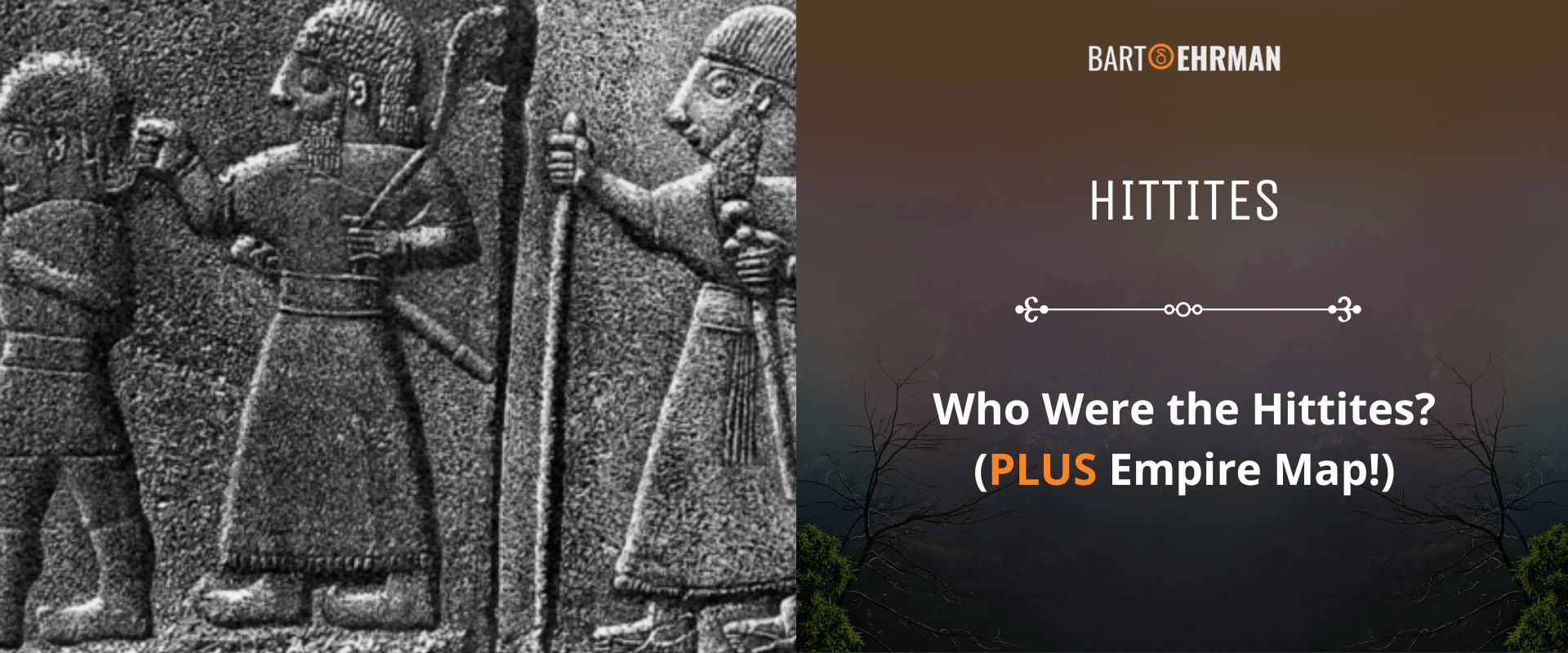Hittites: Who Were the Hittites? (PLUS Empire Map!)

Written by Joshua Schachterle, Ph.D
Author | Professor | BE Contributor
Verified! See our editorial guidelines
Verified! See our guidelines
Disclaimer: The views and opinions expressed in this article belong to the author and do not necessarily match my own. - Dr. Bart D. Ehrman
In Exodus 3:8, God speaks to Moses through the burning bush, telling him he will deliver the Israelites from slavery. But where will they go after they are freed? God says:
I have come down to deliver them from the Egyptians and to bring them up out of that land to a good and spacious land, to a land flowing with milk and honey, to the country of the Canaanites, the Hittites, the Amorites, the Perizzites, the Hivites, and the Jebusites.
That’s a lot of “ites!” But who are all these people? Well, today I’m going to tell you about one of those “ites” that is referenced frequently throughout the Hebrew Bible: the Hittites.
So, who were the Hittites? What language did they speak? What did the Hittites look like? Why are they mentioned so often in the Hebrew Bible, and where are they today? In this article, I’ll answer these questions and more.

What’s In a Name?
The Hittites (Hebrew: “Ha Hittim”) referred to in the Hebrew Bible called their empire Hattusa, which was also the name of their capital city. According to Vladislav Ardzinba, they took this name from an earlier civilization known as the Hattians who had lived in the region of Anatolia (modern-day Turkey) and had spoken a completely different language called Hattic.
In his book 1177 B.C.: The Year Civilization Collapsed, Eric Cline writes that the people we call the Hittites probably called themselves Neshites after Nesha, initially the most prosperous city of their Empire. He notes, however, that around 1650 BCE, a new Hittite capital city was established at Hattusa. The “Hittites” meaning in Hebrew was simply “people of Hattusa.”
What Does the Hebrew Bible Say About the Hittites?
Ilan Peled notes that the Hittites are mentioned 54 times in the Hebrew Bible. For example, in Genesis 49:29-32, we find that Abraham had bought a field called Machpelah that had a cave used for burials. Abraham and Sarah, Isaac and Rebecca, and Jacob and Leah were all buried in that cave.
Esau, son of Isaac and brother of Jacob, married a Hittite woman according to Genesis 26:34 and 36:2. The Bible generally frames this union negatively. In Genesis 27:46, for example, Esau’s mother Rebecca, worried that her other son Jacob would also marry a Hittite woman, tells her husband Isaac, “I am weary of my life because of the Hittite women. If Jacob marries one of the Hittite women such as these, one of the women of the land, what good will my life be to me?”
The frequent biblical references to Hittites give the impression that there were many of them living in the land of Canaan at the time of the Jewish patriarchs, Abraham, Isaac, and Jacob. But even later, during the period of the kingdoms of Judah and Israel, they continue to be mentioned.
For instance, a woman named Bathsheba, whom King David desired, was married to a man called Uriah the Hittite, a member of David’s army. David arranges to have Uriah killed so that he can have Bathsheba for himself (2 Samuel 11–12; 23:39; 1 Kings 15:5; 1 Chronicles 11:41). Interestingly, though, the biblical story makes it seem entirely normal that a Hittite would serve in David’s Judahite army.
Despite these biblical references to the Hittites, the archeological record of their civilization is not in complete agreement with the biblical record.
What Does Archeology Tell Us About the Hittites? (MAP INCLUDED)
Ilan Peled says that there are two eras in which archeological evidence shows the prominence of the Hittites. The first comes from the original Hattians who lived in the Bronze Age (17th-12th centuries BCE). The second is in the Iron Age (9th-6th centuries BCE), the time of the Israelite kingdoms, including that of King David.
Archaeology tells us that this second Hittite Empire ruled over the region of Anatolia, which comprises most of modern-day Turkey, as well as parts of northern Syria (see the Hittite map below). Its capital city, Hattusa, was about 93 miles from the modern Turkish city of Ankara.
Hattusa: The Capital City of th Hittite Empire
In some ways, the city of Hattusa was in an odd location, rather isolated geographically upon a plateau. However, in her book The Hittites and Their World, Billie Jean Collins writes that this location may have been chosen because of the Büyükkale, a huge outcropping of rock that loomed over the city and formed a natural defensive barrier. There was also a year-round water supply in the area.
Hattusa was huge, covering 400 acres and including Upper and Lower cities. Collins writes that, in the ruins of the Lower City, archeologists have found the Great Temple, dedicated to the Storm God and the Sun Goddess, who were the chief deities of the Hittite pantheon. While this is by far the largest temple, over 30 smaller temples have been excavated within the Hattusa site.
From decorations on city walls and temples, it is clear that water and rock were both important elements in Hittite religion. For instance, E.C. Krupp writes that the Hittite king Tudhaliya IV built a shrine to the god Saruma, locating it within a naturally occurring rock sanctuary called Yazilikaya that featured impressive rock-cut reliefs.
What Language Did the Hittites Speak?
Perhaps the most important archeological finds in Hattusa have been the cuneiform tablets, which give us most of our information about the Hittites. Early on, scholars had a difficult time deciphering the Hittite language. However, it was eventually discovered that it was the earliest-known Indo-European language, a language family which includes English, German, Latin, and other languages derived from them.
Based on this language family, most scholars assume that the Hittites were originally one of many nomadic groups living in what is now southern Russia. They then traveled south through the Caucasus and the Black Sea region, eventually inhabiting central Anatolia.
What did the Hittites look like?
It’s impossible to know. As Billie Jean Collins writes, outside of the Hebrew Bible, the classical sources are entirely silent about them.
WHAT HAPPENED TO THE HITTITE EMPIRE?
According to cuneiform tablets found in excavations at Hattusa, says Ilan Peled, in 1650 BCE, after the Hittite king Hattušili I relocated the capital of the Hittite Empire to a city he named Hattusa, the Hittites were gradually able to expand the Empire’s borders, even reaching the city of Babylon, which they pillaged.
However, this gradual and violent expansion led to conflict with Egypt, the other major empire of that time and region. These two superpowers lived in constant tension, alternating who had the upper hand over decades. However, in 1274 BCE, this tension resulted in the Battle of Kadesh, one of the best-known military conflicts in the ancient Near East.
In the build-up to this conflict, the widow of the Pharaoh Tutankhamen wrote to the Hittite king Šuppiluliuma, asking him to send one of his own sons to marry her. Eric Cline writes that this would likely have eased the conflict and even allowed a joint Hittite-Egyptian empire to form. No doubt understanding this, the king agreed and sent one of his sons. Unfortunately, the son was killed on the way to Egypt, probably by members of the Egyptian court who opposed the marriage.
Enraged, King Šuppiluliuma sent his armies to attack the Egyptian-controlled area on the Syrian border between the two empires. After this, the conflict between them seemed to ease until Šuppiluliuma’s death, when the Hittites began again to expand their borders, eventually leading to the Battle of Kadesh in 1274 BCE.
The Egyptian army, led by Ramesses II, was caught by a Hittite ambush, led by King Muwatalli II and his brother Hattušili III. An Egyptian inscription has been found which declares that, despite heavy losses on both sides, Egypt won the battle.
In reality, though, according to A History of Ancient Egypt by Nicolas Grimal, the battle was probably a draw. Egypt eventually retreated from the city of Kadesh which allowed the Hittites to expand further into Syrian territory. Eventually, the two superpowers signed a peace treaty, which was found on cuneiform tablets in the royal palace at Hattusa.
Despite all their successes, however, in the 12th century BCE, the Hittites would share the fate of other regional superpowers such as Egypt, Assyria, and Babylonia. All would diminish in strength and territory until some, the Hittites included, finally disappeared altogether around the time that the Israelite kingdoms were emerging.
Although the genetic remnants of Hittites might live on partially in some of the people of Syria, Turkey, and Lebanon, it’s impossible to know for sure. But if that’s the case, who are all the ubiquitous Hittites in the Bible, especially in the time of David? Hadn’t they disappeared by that time they were written about?
Aharon Kempinski writes that, as I said above, there were two periods of Hittites. The first, from the 17th to the 12th century BCE, were the original Hittites who are seemingly referred to in the Genesis stories about Abraham, Isaac, and Jacob.
The second, from the 9th to the 6th centuries BCE, are now called the Neo-Hittites by scholars and were present during the emergence of the Israelite Kingdoms, including that of King David. Also, we have to remember that, according to biblical scholars, the events of Genesis were written about hundreds of years after they would have happened.
Because of this, Billie Jean Collins and others have theorized that any and all biblical references to the Hittites are only referring to the Neo-Hittites. The original Hittites and their cultural legacy were long gone by the time the Pentateuch was written.
Conclusion
The Hittites are mentioned many times in the Hebrew Bible, although there are no Hittites today. However, since the stories of the Hebrew Bible are often at odds with archeological evidence, can we confirm that they even existed?
In fact, we have a lot of archeological evidence for the Hittite Empire, most of it from excavations of their capital city Hattusa. We know, for example, that they wrote in cuneiform, that their religion consisted of a large pantheon and thematic emphases on rock and water.
We also know that for a time, the Hittites expanded their empire, occupying most of what is now the country of Turkey, as well as parts of Syria. This brought them into conflict with other great powers of the time, including Egypt. Eventually, their empire would wane and they would disappear from history.
In addition, we know that there were two different groups: the Hittites and the Neo-Hittites. According to most scholars, the Hittites mentioned repeatedly in the Bible were the Neo-Hittites; the first Hittites had ceased to exist by the time the Pentateuch was written.


